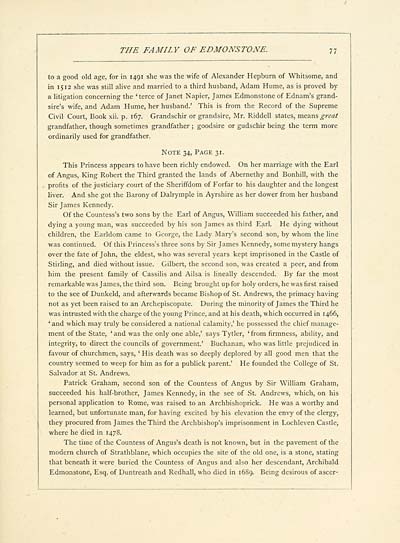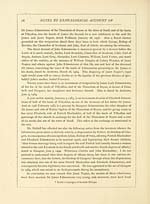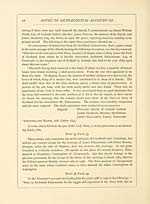Download files
Complete book:
Individual page:
Thumbnail gallery: Grid view | List view

THE FAMILY OF EDMONSTONE. 77
to a good old age, for in 1491 she was the wife of Alexander Hepburn of Whitsome, and
in 15 12 she was still alive and married to a third husband, Adam Hume, as is proved by
a litigation concerning the ' terce of Janet Napier, James Edmonstone of Ednam's grand-
sire's wife, and Adam Hume, her husband.' This is from the Record of the Supreme
Civil Court, Book xii. p. 167. Grandschir or grandsire, Mr. Riddell states, means great
grandfather, though sometimes grandfather ; goodsire or gudschir being the term more
ordinarily used for grandfather.
Note 34, Page 31.
This Princess appears to have been richly endowed. On her marriage with the Earl
of Angus, King Robert the Third granted the lands of Abernethy and Bonhill, with the
profits of the justiciary court of the Sheriffdom of Forfar to his daughter and the longest
liver. And she got the Barony of Dalrymple in Ayrshire as her dower from her husband
Sir James Kennedy.
Of the Countess's two sons by the Earl of Angus, William succeeded his father, and
dying a young man, was succeeded by his son James as third Earl. He dying without
children, the Earldom came to George, the Lady Mary's second son, by whom the line
was continued. Of this Princess's three sons by Sir James Kennedy, some mystery hangs
over the fate of John, the eldest, who was several years kept imprisoned in the Castle of
Stirling, and died without issue. Gilbert, the second son, was created a peer, and from
him the present family of Cassilis and Ailsa is lineally descended. By far the most
remarkable was James, the third son. Being brought up for holy orders, he was first raised
to the see of Dunkeld, and afterwards became Bishop of St. Andrews, the primacy having
not as yet been raised to an Archepiscopate. During the minority of James the Third he
was intrusted with the charge of the young Prince, and at his death, which occurred in 1466,
'and which may truly be considered a national calamity,' he possessed the chief manage-
ment of the State, ' and was the only one able,' says Tytler, ' from firmness, ability, and
integrity, to direct the councils of government.' Buchanan, who was little prejudiced in
favour of churchmen, says, ' His death was so deeply deplored by all good men that the
country seemed to weep for him as for a publick parent.' He founded the College of St.
Salvador at St. Andrews.
Patrick Graham, second son of the Countess of Angus by Sir William Graham,
succeeded his half-brother, James Kennedy, in the see of St. Andrews, which, on his
personal application to Rome, was raised to an Archbishoprick. He was a worthy and
learned, but unfortunate man, for having excited by his elevation the envy of the clergy,
they procured from James the Third the Archbishop's imprisonment in Lochleven Castle,
where he died in 1478.
The time of the Countess of Angus's death is not known, but in the pavement of the
modern church of Strathblane, which occupies the site of the old one, is a stone, stating
that beneath it were buried the Countess of Angus and also her descendant, Archibald
Edmonstone, Esq. of Duntreath and Redhall, who died in 1689. Being desirous of ascer-
to a good old age, for in 1491 she was the wife of Alexander Hepburn of Whitsome, and
in 15 12 she was still alive and married to a third husband, Adam Hume, as is proved by
a litigation concerning the ' terce of Janet Napier, James Edmonstone of Ednam's grand-
sire's wife, and Adam Hume, her husband.' This is from the Record of the Supreme
Civil Court, Book xii. p. 167. Grandschir or grandsire, Mr. Riddell states, means great
grandfather, though sometimes grandfather ; goodsire or gudschir being the term more
ordinarily used for grandfather.
Note 34, Page 31.
This Princess appears to have been richly endowed. On her marriage with the Earl
of Angus, King Robert the Third granted the lands of Abernethy and Bonhill, with the
profits of the justiciary court of the Sheriffdom of Forfar to his daughter and the longest
liver. And she got the Barony of Dalrymple in Ayrshire as her dower from her husband
Sir James Kennedy.
Of the Countess's two sons by the Earl of Angus, William succeeded his father, and
dying a young man, was succeeded by his son James as third Earl. He dying without
children, the Earldom came to George, the Lady Mary's second son, by whom the line
was continued. Of this Princess's three sons by Sir James Kennedy, some mystery hangs
over the fate of John, the eldest, who was several years kept imprisoned in the Castle of
Stirling, and died without issue. Gilbert, the second son, was created a peer, and from
him the present family of Cassilis and Ailsa is lineally descended. By far the most
remarkable was James, the third son. Being brought up for holy orders, he was first raised
to the see of Dunkeld, and afterwards became Bishop of St. Andrews, the primacy having
not as yet been raised to an Archepiscopate. During the minority of James the Third he
was intrusted with the charge of the young Prince, and at his death, which occurred in 1466,
'and which may truly be considered a national calamity,' he possessed the chief manage-
ment of the State, ' and was the only one able,' says Tytler, ' from firmness, ability, and
integrity, to direct the councils of government.' Buchanan, who was little prejudiced in
favour of churchmen, says, ' His death was so deeply deplored by all good men that the
country seemed to weep for him as for a publick parent.' He founded the College of St.
Salvador at St. Andrews.
Patrick Graham, second son of the Countess of Angus by Sir William Graham,
succeeded his half-brother, James Kennedy, in the see of St. Andrews, which, on his
personal application to Rome, was raised to an Archbishoprick. He was a worthy and
learned, but unfortunate man, for having excited by his elevation the envy of the clergy,
they procured from James the Third the Archbishop's imprisonment in Lochleven Castle,
where he died in 1478.
The time of the Countess of Angus's death is not known, but in the pavement of the
modern church of Strathblane, which occupies the site of the old one, is a stone, stating
that beneath it were buried the Countess of Angus and also her descendant, Archibald
Edmonstone, Esq. of Duntreath and Redhall, who died in 1689. Being desirous of ascer-
Set display mode to:
![]() Universal Viewer |
Universal Viewer | ![]() Mirador |
Large image | Transcription
Mirador |
Large image | Transcription
Images and transcriptions on this page, including medium image downloads, may be used under the Creative Commons Attribution 4.0 International Licence unless otherwise stated. ![]()
| Histories of Scottish families > Genealogical account of the family of Edmonstone of Duntreath > (95) Page 77 |
|---|
| Permanent URL | https://digital.nls.uk/95354595 |
|---|
| Description | A selection of almost 400 printed items relating to the history of Scottish families, mostly dating from the 19th and early 20th centuries. Includes memoirs, genealogies and clan histories, with a few produced by emigrant families. The earliest family history goes back to AD 916. |
|---|

